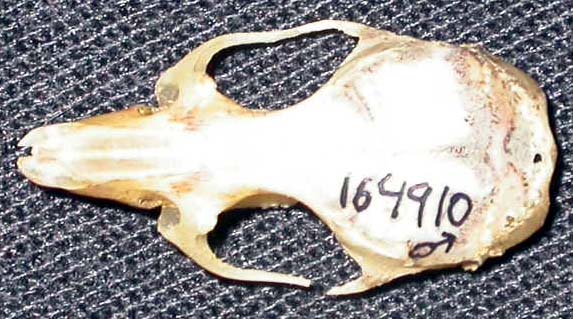Oligoryzomys chacoensis - Chacoan Pygmy Rice Rat

Photo by Christopher Yahnke, collection of the Field
Museum of Natural History
Physical Description:
Measurements: HB=70-110; T=85-155; HF=20-30; E=11-17; WT=9-40g (Emmons 1990).
According to Emmons (1990), the upper parts are tawny yellow-brown, mixed with black hairs on back producing hispid look; muzzle, sides of head and neck, and sometimes forequarters tawny gray; and the underparts are gray, with hairs gray to base. The fur is short in warm lowlands, long in cold climates. Whiskers are usually short, sometimes reach ear tip but not shoulder. Eyeshine is bright. Tail is very slender, much longer than head and body, naked, with a few gray hairs protruding beyond tip. The muzzle is pointed, the ears are oval. Females have four pairs of mammae.
The
skull is small but stout, the rostrum relatively broad and stocky, and the
interorbit hourglass-shaped with squared edges. The four
hind toes bear tufts of silvery bristles that project beyond the ends of the
claws (Nowak 1999).

Photo by Christopher Yahnke,
collection of the Field Museum of Natural History
Distribution:
According to Wilson and Reeder (1995), type of locality of Oligoryzomys chacoensis is Paraguay, Boqueron Dept., km 419 along Trans Chaco Hwy, northwest of Villa Hayes; its distribution is dryer habitats of W Paraguay, SE Bolivia, WC Brazil, and N Argentina; it may be more broadly distributed in cerrado and caatinga habitats in SE Brazil.
Ontogeny and
Reproduction:
Chacoan pygmy rice rats breed during the spring and summer; litter size averages are about 5 and ranges from 2 to 11 (Nowak 1999).
Ecology and Behavior:
According to Emmons (1990), chacoan pygmy rice rats are nocturnal, terrestrial, but climb well. They are solitary. They feed on seeds, fruits, and insects. They occur in a wide range of habitats, including tropical and dry forests, arid lowlands, and montane grasslands; they prefer areas with dense vegetation and are numerous in secondary brush, gardens, rice fields, and plantations; they commonly occupy houses and camps in rainforest clearings (Nowak 1999).
Remarks:
There are about 10-15 species in Oligoryzomys spp. All the species are similar in external appearance and difficult to distinguish in the field (Emmons, 1990). According to Nowak (1999), Oligoryzomys commonly has been treated as subgenus of Oryzomys but was considered a distinct genus by Carleton and Musser (1989).
Oligoryzomys chacoensis can be agricultural pests in rice fields and storage barns (Emmons 1990). It hosts the New World Hantavirus, Bermejo, which can be transmitted to humans (Centers for Disease Control and Prevention 2004).
Literature Cited:
Neotropical Rainforest Mammals: A Field Guide. Louise H. Emmons. The University of Chicago Press, Chicago. 1990. Pg 180 (1).
Walker’s Mammals of the World. Sixth Edition. Volume II. Ronald M. Nowak. The Johns Hopkins University Press, Baltimore and London. 1999. Pg 1367 (1).
Mammal Species of the World: a taxonomic and geographic reference. Second Edition. Don E. Wilson and DeeAnn M. Reeder. Smithsonian Institution
Press, Washington and London. 1995.
Mammal Species of the World. 2004. http://nmnhgoph.si.edu/msw/ (Accessed December 2004).
Centers for Disease Control and Prevention. 2004. All About Hantavirus. http://www.cdc.gov/ncidod/diseases/hanta/hps/noframes/hpsslideset/hpsslides1-12.htm (Accessed December 2004).
Reference written by Kaori Kobayashi, Biology 378 (Mammalogy), University of Wisconsin – Stevens Point. Edited by Christopher Yahnke. Page last updated August 15, 2005.
